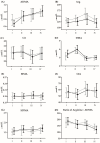Ubiquinone (Coenzyme Q-10) Supplementation Influences Exercise-Induced Changes in Serum 25(OH)D3 and the Methyl-Arginine Metabolites: A Double-Blind Randomized Controlled Trial
- PMID: 39061829
- PMCID: PMC11274209
- DOI: 10.3390/antiox13070760
Ubiquinone (Coenzyme Q-10) Supplementation Influences Exercise-Induced Changes in Serum 25(OH)D3 and the Methyl-Arginine Metabolites: A Double-Blind Randomized Controlled Trial
Abstract
Researchers have studied the effects of exercise on serum methyl-arginine and vitamin D metabolites; however, the effects of exercise combined with antioxidants are not well documented. Since oxidative stress affects the metabolism of vitamin D and methyl-arginine, we hypothesised that the antioxidant coenzyme Q10 (CoQ10) might modulate exercise-induced changes. A group of twenty-eight healthy men participated in this study and were divided into two groups: an experimental group and a control group. The exercise test was performed until exhaustion, with gradually increasing intensity, before and after the 21-day CoQ10 supplementation. Blood samples were collected before, immediately after, and 3 and 24 h after exercise. CoQ10, vitamin D metabolites, asymmetric dimethylarginine (ADMA), symmetric dimethylarginine, methylarginine, dimethylamine, arginine, citrulline, and ornithine were analysed in serum samples. CoQ10 supplementation caused a 2.76-fold increase in the concentration of serum CoQ10. Conversely, the 25(OH)D3 concentration increased after exercise only in the placebo group. ADMA increased after exercise before supplementation, but a decrease was observed in the CoQ10 supplementation group 24 h after exercise. In conclusion, our data indicate that CoQ10 supplementation modifies the effects of exercise on vitamin D and methyl-arginine metabolism, suggesting its beneficial effects. These findings contribute to the understanding of how antioxidants like CoQ10 can modulate biochemical responses to exercise, potentially offering new insights for enhancing athletic performance and recovery.
Keywords: 24,25(OH)2D3; 25(OH)D3; 3-epi-25(OH)D3; coenzyme Q10; endurance exercise; ubiquinone.
Conflict of interest statement
The authors declare no conflicts of interest. The funders played no role in the design of the study, the collection, analysis, or interpretation of data, the writing of the manuscript, or the decision to publish the results.
Figures





References
-
- Agudelo L.Z., Femenia T., Orhan F., Porsmyr-Palmertz M., Goiny M., Martinez-Redondo V., Correia J.C., Izadi M., Bhat M., Schuppe-Koistinen I., et al. Skeletal muscle PGC-1alpha1 modulates kynurenine metabolism and mediates resilience to stress-induced depression. Cell. 2014;159:33–45. doi: 10.1016/j.cell.2014.07.051. - DOI - PubMed
-
- Orlando P., Silvestri S., Galeazzi R., Antonicelli R., Marcheggiani F., Cirilli I., Bacchetti T., Tiano L. Effect of ubiquinol supplementation on biochemical and oxidative stress indexes after intense exercise in young athletes. Redox Rep. 2018;23:136–145. doi: 10.1080/13510002.2018.1472924. - DOI - PMC - PubMed
Grants and funding
LinkOut - more resources
Full Text Sources

